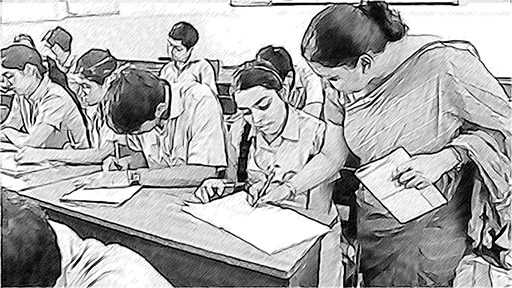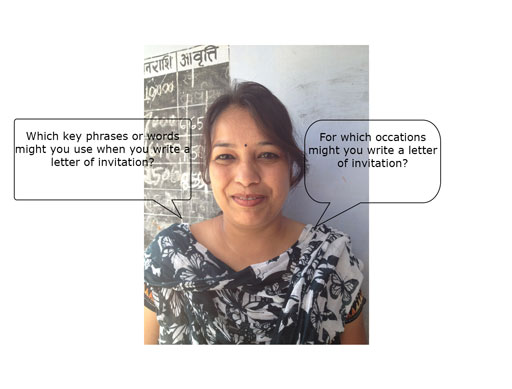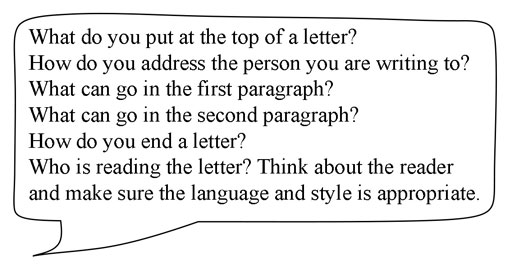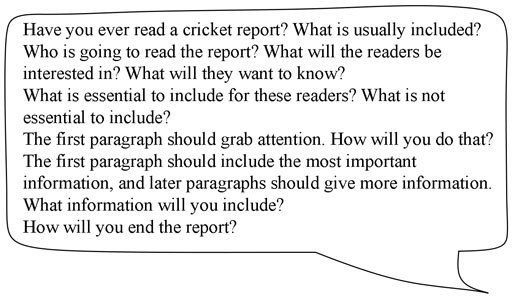2 Making text writing meaningful
Before they write, students need time to organise their ideas and information. They can do this by making notes in their notebook, maybe moving ideas around as they work.
As students plan their written work, it is important that they know the kind of text that they are writing and who their potential readers are.
It can be very useful to get students to share ideas and plan in pairs because it:
- gives students confidence in their ability to write
- helps students to develop writing and language skills
- enables students to learn from each other
- ensures everyone’s participation.
Case Study 2: Using pair work in writing
Mrs Jadhev teaches English to Class IX. Her students were practising writing a letter of invitation. First of all, she asked for ideas to start all students thinking about invitation letters.
Students shared their ideas and I wrote them on the board. Then I asked them some questions about letters, and how they are usually structured.
I then told students to decide which letter of invitation they wanted to write using the ideas they had suggested (for example, inviting a friend to a brother’s wedding), and to make some notes about what they wanted to include in the letter, and how they were going to organise it. I gave them ten minutes to do this.
After this, I asked my students to work together in pairs and to share and discuss their preliminary notes. I encouraged students to add to or delete from what they had written, and to discuss how the letter was organised.
There was a buzz in the class as students discussed their ideas with each other, and with me. They also looked up words in the class dictionary. While they were working, I moved around the class, checking what was happening, and helping students where they needed it. I also encouraged students to use English in their discussions, speaking to them in English myself as much as possible.

After the students had finished sharing their ideas, each student wrote the first draft of their letter. Once again, I moved around the room as they were writing to observe. I noticed that most students’ letters were of a better quality than usual, with the ideas organised in a much more logical way.
Once the students had finished writing their letters, I asked them to exchange their letters with each other and to pretend that they were the person that the letter was addressed to. They then had to write a reply to the letter. The students really enjoyed seeing what the reply to their letter was! It made me realise that when we write something, there is usually a reader in mind. It’s good for students to know that somebody is going to read what they are writing in English, and is going to respond to what they write.
invitation before they started writing one.
It is important that students are familiar with the structures of different texts before they start writing – you can show them examples and models of different texts (see the unit Supporting independent writing in English). It helps students if you use these examples to discuss the features of different texts before they begin writing. Discussion points may include:
- Is it factual or opinionated?
- Is it formal or informal?
- What kind of verb tenses are used?
Activity 2: Thinking of suitable prompts for brainstorming
Follow these steps to try a similar approach in your classroom:
- Select a writing task from your textbook, or one that your students typically do for their examinations. For example: a letter of invitation, or an application; a composition about a topic such as a picnic; an article or a report for a newspaper; a page from a diary, and so on.
- Do a brainstorming session about the topic as a whole class or with students in groups.
- Ask questions to help students organise the text. For example, imagine your students have to write a report for a newspaper about a local cricket match. You could ask them the following questions:
- Give students some time (such as five minutes) to note down their ideas individually.
- Put students into pairs and ask them to share their ideas and discuss how to organise them. The input of classmates helps students to plan a better text – they may add or delete ideas; or they may decide to organise their ideas differently. Again, give a time limit for this activity (such as ten minutes). This keeps students motivated and focused on what they are doing. Move around the room as everyone works, and help where necessary.
- Tell students to write the text, and give an appropriate time limit. Remind them to follow their plan; to divide the text into paragraphs; to pay attention to spelling and grammar; and to keep in mind who the reader is (a sports fan, in this case!)
Pause for thought Here are some questions for you to think about after trying this activity. If possible, discuss these questions with a colleague.
|
Remember that you can change around the students in your groups to make more effective pairs. Sometimes students get bored of working with each other; sometimes students work better with students of a similar ability. Experiment and see what works best. Planning takes time, and the amount of time will vary depending on the task or topic. It can be a good idea to give a time limit for planning, and to tell students the benefits of planning.
1 Generating ideas for writing



